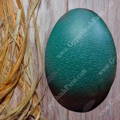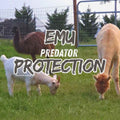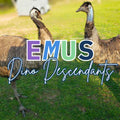
Understanding Emu Egg Variations
Explore the fascinating world of emu eggs, from undersized and oversized variations to soft-shelled and unusual shapes. Learn about the factors influencing egg size and quality, including nutrition, age, and environmental stressors. Discover how these unique characteristics affect hatchability and the health of emu chicks.
Age, nutrition and environmental factors all play a role in emu egg development.
Subscribe
To join our mailing list and never miss an update!
Emu eggs are remarkable in their own right, but not all of them fit the typical mold. Some emu eggs can be undersized, oversized, or even take on unusual shapes. This article delves into the fascinating world of emu eggs, exploring the variations that can occur and what they reveal about the health and environment of these incredible birds.

1. UNDERSIZED EMU EGGS
Emu eggs are weighed and recorded in grams. The average emu egg weighs roughly 550 grams. Any emu egg that weighs under 400 grams is considered undersized. This is most common in first year layers. As the female emu’s reproductive system reaches maturity, the number of undersized eggs should decrease. Most females that lay undersized eggs their first season do adjust and lay larger eggs the following season.
An undersized egg does not mean it is not viable to hatch. In fact, most will hatch out perfectly healthy emu chicks but they may be smaller than chicks hatched out of normal sized eggs. In most cases, the chicks will catch up in size to their fellow hatchlings as they develop through the juvenile stage.
Undersized emu eggs can result from several factors, particularly in younger or first-year layers. Here are the main causes:
• Immaturity of the Reproductive System: In first-year layers, the reproductive system may not yet be fully developed, leading to the production of smaller eggs. As the bird matures, the eggs typically increase in size.
• Nutritional Deficiencies: A diet lacking in essential nutrients, particularly proteins, fats, or calcium, can affect egg size. Proper nutrition is crucial for the production of well-formed eggs.
• Stress or Environmental Factors: Stressful conditions such as extreme weather, sudden changes in the environment, or disturbances in the flock can interfere with the egg-laying process, resulting in smaller eggs.
• Hormonal Imbalances: The hormonal regulation of egg production plays a key role in determining the size of the egg. Disruptions in hormone levels, especially during the early laying periods, can lead to undersized eggs.
• Genetics: In some cases, certain emus may be genetically predisposed to laying smaller eggs, especially during their early laying years.
• Illness or Poor Health: Underlying health issues or diseases can interfere with proper egg formation, causing smaller eggs.
As emus continue to lay over multiple seasons, these factors typically diminish, and the bird begins producing normal-sized eggs.

2. OVERSIZED EMU EGGS
As mentioned above, the average weight for an emu egg is 550 grams. However, females will occasionally lay an egg in the 650–700-gram range. We frequently get 650+ gram emu eggs at Gypsy Shoals Farm. The largest emu egg on record weighed 2,550 grams (5.6 pounds) and measured 13.6 inches in length. This enormous egg was laid on June 25, 2015, at the "Coal Point" emu farm in Australia. It is recognized by Guinness World Records as the largest emu egg ever recorded.
An oversized egg can form due to several factors related to the bird’s reproductive system. Here are some common causes of oversized eggs:
• Reproductive Irregularities: Sometimes, an egg may spend more time in the reproductive tract than usual. This extended time allows more layers of egg white and shell material to accumulate, resulting in a larger egg.
• Hormonal Imbalances: A disruption in hormone levels, particularly estrogen, can cause irregularities in egg size. Hormonal fluctuations might lead to the development of a larger-than-normal egg.
• Double-Yolk Formation: In some cases, two yolks may be released simultaneously and form a single egg. This is more common in chickens but could occur in emus as well, leading to an unusually large egg due to the additional content inside the shell.
• Age of the Bird: Oversized eggs are sometimes more common in older birds whose reproductive systems may not function as consistently. However, young birds can also lay oversized eggs as their systems are still maturing.
• Genetics: Some individual birds may be genetically predisposed to laying larger eggs, particularly if there are traits in their lineage for producing larger offspring.
• Nutritional Factors: If an emu has access to abundant nutrients, especially in the case of protein and calcium, it may have the physical capacity to produce larger eggs due to optimal reproductive health.
Oversized eggs can place stress on the bird, so while rare, they are sometimes an indication of underlying reproductive health issues.
3. SOFT-SHELLED EMU EGGS
A soft-shelled emu egg is an egg that has an underdeveloped or absent outer shell layer, resulting in a soft, pliable, or leathery egg instead of the typical hard, protective shell. The shell is composed primarily of calcium carbonate, and if the egg lacks sufficient calcium or encounters issues during shell formation, it can result in a soft or thin shell.
Here are some common causes of soft-shelled emu eggs:
• Calcium Deficiency: A lack of sufficient calcium in the bird’s diet is the most common cause. Calcium is essential for forming the hard outer shell, and without it, the egg remains soft.
• Vitamin D Deficiency: Vitamin D is necessary for proper calcium absorption. Without enough vitamin D, even if the bird consumes enough calcium, it may not absorb and utilize it properly, leading to soft-shelled eggs.
• Stress: High levels of stress from environmental factors, predators, or changes in routine can interfere with the reproductive process, potentially leading to soft-shelled eggs.
• Reproductive Issues: If the egg spends insufficient time in the shell gland (the part of the reproductive tract responsible for forming the shell), it may not develop the hard shell properly.
• Age of the Bird: Young, first-year layers or older birds past their prime laying years may be more prone to laying soft-shelled eggs due to an immature or declining reproductive system.
• Health Problems: Infections or illnesses affecting the reproductive organs can disrupt normal egg formation, resulting in soft or malformed eggs.
Soft-shelled eggs are usually non-viable and can be easily damaged due to the lack of protection provided by a proper shell. Additionally, the lack of a protective shell makes them highly susceptible to bacterial invasion. If soft-shelled eggs become a regular occurrence in your mob, there is a need for dietary or environmental adjustments for the birds.
4. chalky shelled emu egg
When an emu lays a chalky egg, it's typically due to an issue with the outer coating of the eggshell, specifically the cuticle. The chalky appearance happens when the cuticle, which is the final layer added to the eggshell, doesn't form properly or is excessively thick. This can be influenced by a few factors:
• Calcium Deposits: Sometimes, the chalky layer is caused by extra calcium deposits on the shell's surface, which can make the egg appear chalky or rough. This is usually related to irregularities in the eggshell formation process within the reproductive tract.
• Environmental Factors: Changes in the bird's environment, such as humidity, temperature, or stress, can affect the way the cuticle forms, leading to a chalky texture.
• Nutrition: While a true calcium deficiency would result in weak or soft eggshells, an imbalance in other minerals or vitamins (like Vitamin D or phosphorus) can interfere with the proper laying process, occasionally leading to chalky eggs.
• Reproductive Health: Any disruptions in the emu's reproductive system or temporary stress can also lead to abnormalities in the shell, including a chalky or rough texture.
5. UNUSUALLY SHAPED EMU EGGS
Unlike chicken eggs which have a distinguishable bulb end and tapered end, emu eggs tend to be more symmetrical, making it difficult at times to distinguish the air sac end of the egg. With that being said, emus have been known to occasionally lay unusual shaped eggs. Two of the most common are the football-shaped (or torpedo) egg and the lemon-shaped egg. The names are self-explanatory but the important thing to remember is that these eggs are still perfectly viable.
However, because of their unusual shape, developing chicks may experience a higher rate of mispositioning inside the egg. This may hinder or stop full development and lower hatchability.
Here are common reasons for the formation of unusual-shaped eggs:
• Reproductive System Irregularities: A temporary disruption in the bird's reproductive tract, such as spasms or muscle contractions, can cause the egg to develop an unusual shape as it passes through the oviduct.
• Stress: External stressors like changes in environment, predators, or overcrowding can affect the egg-laying process.
• Age of the Bird: Young or inexperienced layers, whose reproductive systems are still maturing, and older birds nearing the end of their laying period, are more likely to produce irregularly shaped eggs.
• Nutritional Deficiencies: Lack of proper nutrition, particularly calcium or protein, can cause eggs to form improperly, affecting both the shell shape and structure.
• Genetics: Some birds may be genetically predisposed to producing irregularly shaped eggs, though this is relatively uncommon.
A random unusual-shaped egg does not necessarily indicate any underlying health issues with the bird, but frequent occurrences may suggest the need for environmental or dietary adjustments.
Trending Articles

6. AQUA TIPPED EMU EGG
An "aqua-tipped" emu egg refers to an egg that has a distinctive, lighter bluish or aqua-colored tip, usually at one end of the shell. Emu eggs typically have a dark green or bluish-black shell, but variations in pigmentation can occur, sometimes resulting in areas where the color is lighter or appears more vibrant, such as an aqua hue at the tip.
This color variation is usually the result of natural processes during egg formation:
• Shell Pigmentation Process: Emu eggs get their unique color from pigments deposited during the shell-forming stage in the bird’s oviduct. If the pigmentation is not uniformly applied or is concentrated in certain areas, one end of the egg may appear lighter, leading to an aqua-tipped effect.
• Mineral Deposits: Slight differences in the deposition of minerals or pigments on the shell surface can create variations in color, with some areas taking on a bluish tint.
• Genetics: Some emus may naturally produce eggs with lighter or differently colored tips due to genetic factors influencing shell pigmentation.
While an aqua-tipped emu egg is a natural occurrence, it remains structurally sound and doesn't affect the egg's viability or quality. These unique eggs are often prized for their aesthetic appeal, especially among collectors or those interested in decorative purposes.
Understanding the variations in emu eggs sheds light on the health and well-being of these fascinating birds. While deviations in size and shape are often considered anomalies, they can provide valuable insights into factors like nutrition, stress, and reproductive health. By recognizing that undersized, oversized, or unusually shaped eggs are exceptions rather than the norm, we can appreciate the complexities of emu breeding and the importance of a supportive environment.
Trending Products
Copyright©2024 All rights reserved. We love to have you share our article as long as you include a direct link to this page. This article or any portion thereof , including all images, may not be reproduced or used in any manner whatsoever without the express written permission of Gypsy Shoals Farm.





